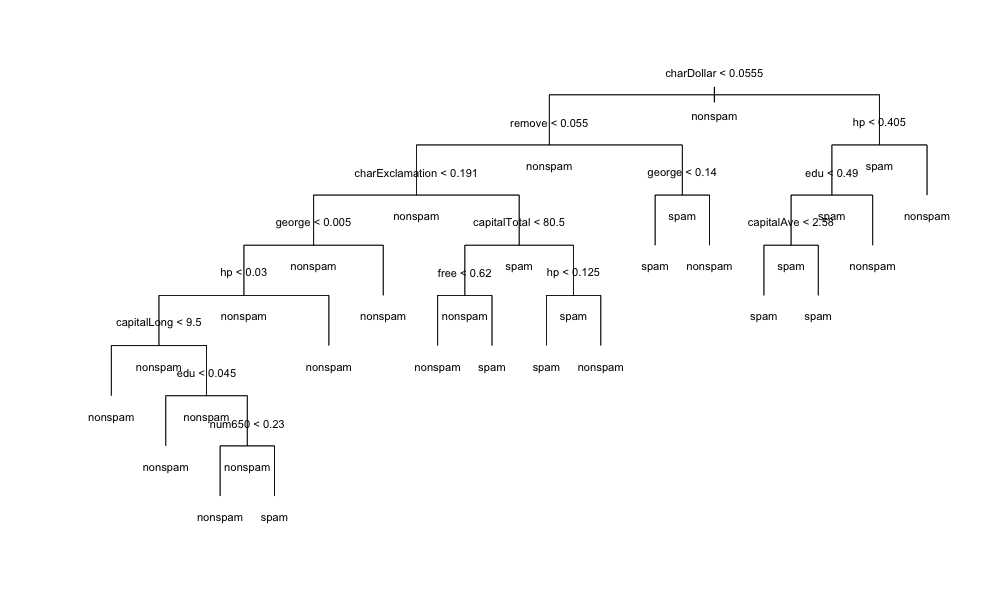标签:
最近的关键字:分类算法,outlier detection, machine learning
简介:
此文将 k-means,decision tree,random forest,SVM(support vector mechine),人工神经网络(Artificial Neural Network,简称ANN )这几种常见的算法 apply 在同一个数据集
spam,看各种方法预测错误率,或准确率,旨在追求预测准确性,辨识出这几种方法的实用性,对背后的理论依据,大量的数学公式,不作讨论(能力有限,看不懂数学公式,,,)
ps:这两天看代码。又发现不少好玩的方法和网站,哦哈哈
先分享几个tips、R blog:
a) 如何快速找到自己想要的R package。到 Available CRAN Packages By Date of Publication control+F 找,快得很。
b) 如何找到一个小领域 一些列相关的R包。以 randomForest 为例,到这个包的页面,你会看到一个 In views: Environmetrics, MachineLearning,接下来就可以把机器学习算法的R包一网打尽。帅呆了,好么,再也不用一个个查了。
c) 挺好的一个 R blog http://mkseo.pe.kr/stats/ 里面有韩文和英文写的文章,不知道博主是个是个韩国妹子呢,,,想多了,,,妹子怎么去coding,,,
d)再推荐一个blog  。拷过来,变成了这样,,戳吧,少年。
。拷过来,变成了这样,,戳吧,少年。
实际应用:
(1)k-means
#----------------------------
基于数据集 spam来看看k-means
library(kernlab)
library(magrittr)
data(spam)
set.seed(124)
res <- kmeans(spam[,-58]%>%sapply(scale),2)
table(spam$type,res$cluster)
1 2
nonspam 2754 34
spam 1813 0
# 错误率是 1-2754/nrow(spam) = 0.4014345
# 假设spam 和 nonspam 五五开,如果完全是蒙,出错率也就50%吧,,,
总结:
分类变量不能用于k-means,不能简单将分类变量编号为1,2,3。能给出每个类别之间的距离,是可以用kmeans的。
必须对每列预先scale。
#----------------------------
(2)decision tree
library(tree) library(kernlab) library(dplyr) library(magrittr) data(spam) #create train and test dataset set.seed(1859) train <- sample(nrow(spam),nrow(spam)*0.7,replace = FALSE) df.train <- spam[train,] df.test <- spam[-train,]
#modeling tree.fit <- tree(type~.,data=df.train) summary(tree.fit)
# plot decision tree plot(tree.fit, type ="uniform") text(tree.fit, pretty =1, all=TRUE,cex=0.7) # predication pred <- predict(tree.fit,df.test,type = c("class")) #查看预测结果 confusionMatrix(pred,df.test[,58]) Confusion Matrix and Statistics Reference Prediction nonspam spam nonspam 819 84 spam 34 444 Accuracy : 0.9146
# decision tree 选择变量模型会自动帮你选择选择,预测错误率是 0.08
放个图

总结:
引用tree这个包帮助文档的一句话:The left-hand-side (response) should be either a numerical vector when a regression tree will be fitted or a factor,when a classification tree is produced. 既可以做classification 也可以 regression!
如果是做classification,Factor predictor variables can have up to 32 levels.
decision tree 会不会 overfitting?我看下来,是不会,用tree.fit对测试集预测时,准确率依然是很高。
帮助文档是这样说的:The split which maximizes the reduction in impurity is chosen, the data set split and the process repeated. Splitting continues until the terminal nodes are too small or too few to be split.
看下面的代码,也可以证明不存在overfitting吧
> summary(tree.fit) Classification tree: tree(formula = type ~ ., data = df.train) Variables actually used in tree construction: [1] "charDollar" "remove" "charExclamation" [4] "george" "hp" "capitalLong" [7] "edu" "num650" "capitalTotal" [10] "free" "capitalAve" Number of terminal nodes: 16 Residual mean deviance: 0.432 = 1384 / 3204 Misclassification error rate: 0.08416 = 271 / 3220
放一篇 文章 Decision Tree - Overfitting
#---------------------------
(3)random forest
library(randomForest) library(magrittr) library(dplyr) data(spam) train <- sample(nrow(spam),nrow(spam)*0.7,replace = FALSE) df.train <- spam[train,] df.test <- spam[-train,] # random forest 要预先设定随机种子,结果才能一样。 set.seed(189) spam.rf <- randomForest(type~.,data=df.train,mtry=3,do.trace=100,ntree=500,importance=TRUE,proximity=TRUE)
#下面是运行时,种到第几百棵树的时候,error rate是多少 ntree OOB 1 2 100: 5.56% 2.95% 9.49% 200: 5.59% 2.69% 9.96% 300: 5.53% 2.79% 9.65% 400: 5.40% 2.84% 9.26% 500: 5.28% 2.69% 9.18%
spam.rf pred <- predict(spam.rf,df.test[,-58],type="class") confusionMatrix(pred,df.test[,58]) Confusion Matrix and Statistics Reference Prediction nonspam spam nonspam 833 41 spam 20 487 Accuracy : 0.9558 # 错误率很低 # random forest 已经自己选择了关键变量,不存在过度拟合的问题
# 下面的命令是看那些变量重要 varImpPlot(spam.rf)
varImpPlot(spam.rf)的运行结果是一张图,charExclamation 这个变量对于预测是不是垃圾邮件,至关重要。

总结:
random forest会不会 overfitting?Random Forest - How to handle overfitting
Breiman claims that RF does not overfit. stat.berkeley.edu/~breiman/RandomForests/cc_home.htm
从预测结果看,是不会overfitting。另外这个包的开发者都声称不会overfitting了,,,
random forest 也是classification 和regression 都能做
放一篇这个包作者的文章:http://www.bios.unc.edu/~dzeng/BIOS740/randomforest.pdf
#---------------------------
(4)SVM (supprot vector mechine)
先看e1071这个包的SVM
library(e1071) library(rpart) set.seed(1871) train <- sample(nrow(spam),nrow(spam)*0.7,replace = FALSE) df.train <- spam[train,] df.test <- spam[-train,] model <- svm(df.train[,-58], df.train[,58]) print(model) summary(model) pred <- predict(model, df.test[,-58]) confusionMatrix(pred,df.test[,58]) Confusion Matrix and Statistics Reference Prediction nonspam spam nonspam 789 59 spam 37 496 Accuracy : 0.9305
再看另一个,来自于caret包,参考 Computational Prediction这篇文章
library(caret) library(doMC) data(spam) set.seed(89) train <- sample(nrow(spam),nrow(spam)*0.7,replace = FALSE) df.train <- spam[train,] df.test <- spam[-train,] # 多线程,是doMC包的函数,看了监视器,确实cpu使用率瞬间飙到90%+。 # 回头仔细研究下和parallel包有什么区别 registerDoMC(cores=4) model <- train(df.train[, -58], df.train[, 58], method="svmRadial") predict(model,df.test[,-58])%>%confusionMatrix(df.test[,58]) # 准确率也还可以 Confusion Matrix and Statistics Reference Prediction nonspam spam nonspam 816 70 spam 42 453 Accuracy : 0.9189
Computational Prediction 这篇里面还发现一个好玩的地方,就是可以用一小函数人为的造出一些缺失值,然后用Bagged tree imputation 补缺失值,还没研究它补缺失值的逻辑是什么,先放一篇文章备查。
Bagged tree imputation for missing values using caret。
fillInNa <- function(d) {
naCount <- NROW(d) * 0.1
for (i in sample(NROW(d), naCount)) {
d[i, sample(4, 1)] <- NA
}
return(d)
}
#---------------------------
(5)人工神经网络(Artificial Neural Network)
参考 R语言中最强的神经网络包RSNNS 和RSNNS 帮助文档,帮助文档在 confusionMatrix(iris$targetsTrain,fitted.values(model)),这一句有错误,必须encodeClassLabels才可以,正确的写法是:confusionMatrix(encodeClassLabels(iris$targetsTrain),encodeClassLabels(fitted.values(model)))
library(RSNNS)
library(doMC)
data(spam)
set.seed(199)
spam <- spam[sample(1:nrow(spam) ,nrow(spam)), 1:ncol(spam)]
spamValues <- spam[,-58]
spamTargets <- spam[,58]
spamDecTargets <- decodeClassLabels(spamTargets)
spam <- splitForTrainingAndTest(spamValues, spamDecTargets, ratio = 0.3)
spam <- normTrainingAndTestSet(spam)
#The model is then built with:
# registerDoMC(cores=4) 看了下活动监视器,CPU使用率在30%左右,这东西在这里没卵用。
# 下面这个函数很耗时
model <- mlp(spam$inputsTrain, spam$targetsTrain, size = 5
,learnFuncParams = c(0.1), maxit = 60
,inputsTest = spam$inputsTest
,targetsTest = spam$targetsTest)
predictions <- predict(model, spam$inputsTest)
confusionMatrix(encodeClassLabels(spam$targetsTest),encodeClassLabels(predictions))
Confusion Matrix and Statistics
Reference
Prediction 1 2
1 805 42
2 34 500
Accuracy : 0.945
95% CI : (0.9316, 0.9564)
No Information Rate : 0.6075
P-Value [Acc > NIR] : <2e-16
Kappa : 0.8843
Mcnemar‘s Test P-Value : 0.422
Sensitivity : 0.9595
Specificity : 0.9225
Pos Pred Value : 0.9504
Neg Pred Value : 0.9363
Prevalence : 0.6075
Detection Rate : 0.5829
Detection Prevalence : 0.6133
Balanced Accuracy : 0.9410
‘Positive‘ Class : 1
预测准确率略低于randomForest,和之前老板提到几个算法中randomForest最牛逼是吻合的。不过人工神经网络计算很耗时间,又回去重新计算,看了下时间
用户 系统 流逝
248.671 26.796 283.194
#---------------------------
(6)贝叶斯网络
最后:
以上各种方法的理论部分,还需继续学习。
对于上面的几种方法介绍,我的代码肯定还有纰漏,或者错误,请允许我慢慢改进,轻拍。
标签:
原文地址:http://www.cnblogs.com/litao1105/p/4715544.html